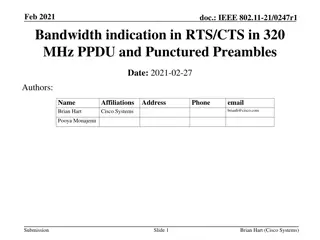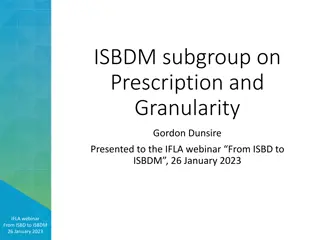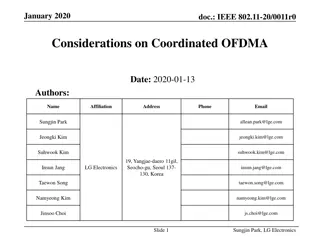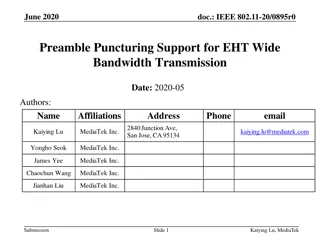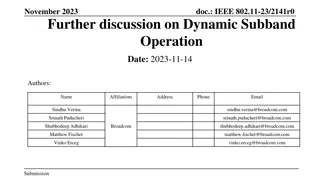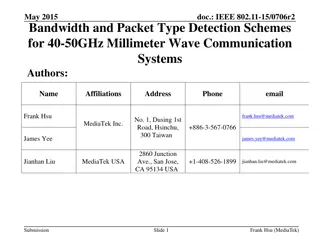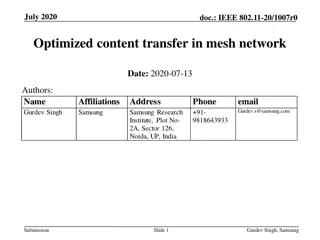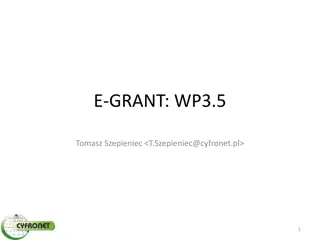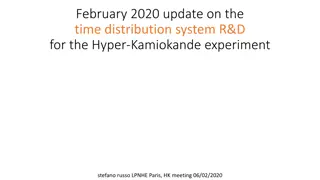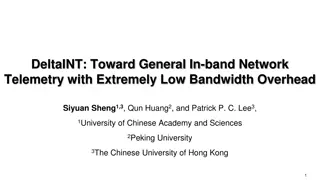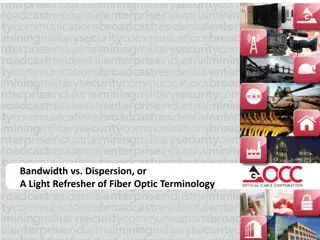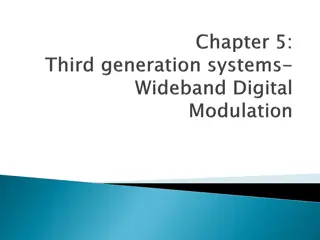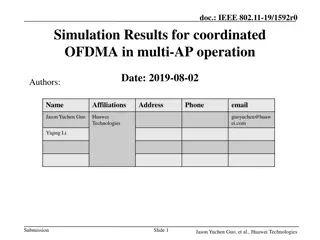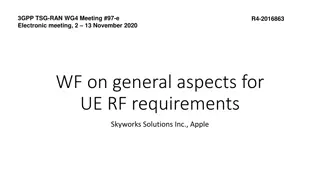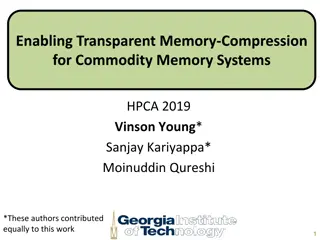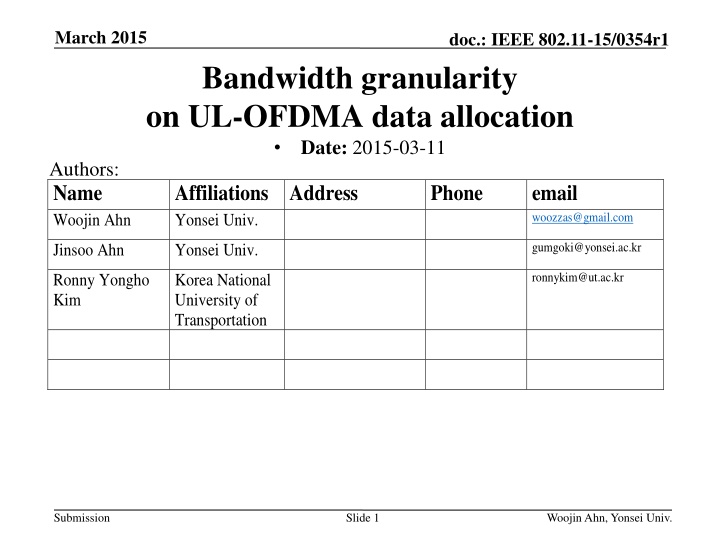
Developing UL-OFDMA Procedure for Enhanced Throughput in 802.11ax
Explore the development of UL-OFDMA procedure in IEEE 802.11-15/0354r1 for throughput enhancement. The document delves into bandwidth granularity on UL-OFDMA data allocation, the inclusion of UL-OFDMA in the Spec Framework Document for 11ax, and the procedures involved in UL-OFDMA implementation. Various aspects such as AP initiation, scheduling, primary ACK, UL data procedure, and more are discussed to optimize multiple STAs support and bandwidth allocation. Considerations for finer granularity of bandwidth occupation, control mechanisms, and signaling structures are examined, emphasizing the need for efficient protocols to cater to the evolving wireless standards.
Download Presentation

Please find below an Image/Link to download the presentation.
The content on the website is provided AS IS for your information and personal use only. It may not be sold, licensed, or shared on other websites without obtaining consent from the author. If you encounter any issues during the download, it is possible that the publisher has removed the file from their server.
You are allowed to download the files provided on this website for personal or commercial use, subject to the condition that they are used lawfully. All files are the property of their respective owners.
The content on the website is provided AS IS for your information and personal use only. It may not be sold, licensed, or shared on other websites without obtaining consent from the author.
E N D
Presentation Transcript
March 2015 doc.: IEEE 802.11-15/0354r1 Bandwidth granularity on UL-OFDMA data allocation Date: 2015-03-11 Authors: Name Woojin Ahn Affiliations Address Yonsei Univ. Phone email woozzas@gmail.com gumgoki@yonsei.ac.kr Jinsoo Ahn Yonsei Univ. ronnykim@ut.ac.kr Ronny Yongho Kim Korea National University of Transportation Submission Slide 1 Woojin Ahn, Yonsei Univ.
March 2015 doc.: IEEE 802.11-15/0354r1 Introduction UL-OFDMA is included in Spec Framework Document for 11ax [1],[2] Key enabling technique to meet the requirement of throughput enhancement Unlike the conventional 802.11, simultaneous transmission of multiple STAs should be supported It is necessary to decide how to support multiple UL data for further developing UL-OFDMA procedure Bandwidth granularity of multiple UL data allocation Considering wideband, larger FFT size 20MHz based or sub-channel based channel occupation Submission Slide 2 Woojin Ahn, Yonsei Univ.
March 2015 doc.: IEEE 802.11-15/0354r1 UL-OFDMA procedure AP Initiation Scheduling Primary ACK UL Data procedure STAs AP Secondaries Initiation Scheduling ACK UL Data procedure STAs Initiation (AP) UL-OFDMA procedure start indication Synchronization of UL-OFDMA procedure Channel availability indication of AP Duplicated for available channel from AP s perspective Scheduling (AP, STAs) STA Medium contention (Resource request) UL-data length and AC indication Channel availability indication of STAs AP Resource (Channel) allocation Explicit or implicit Submission Slide 3 Woojin Ahn, Yonsei Univ.
March 2015 doc.: IEEE 802.11-15/0354r1 How do we develop UL-OFDMA procedure? The very first step of designing UL-OFDMA Procedural detail may vary depending on the target environment/situation/traffic/STA Among these ingredients, we more focus on how many STAs can be allowed in a single UL-OFDMA session The granularity of bandwidth occupation will determine the number of tx-STA of UL-OFDMA Submission Slide 4 Woojin Ahn, Yonsei Univ.
March 2015 doc.: IEEE 802.11-15/0354r1 Multiple STAs UL bandwidth occupation in UL-OFDMA In conventional 802.11, minimum bandwidth occupation is 20MHz Only one tx-STA is allowed Control mechanism/signaling/frame structure have been designed based on 20MHz channel DL-OFDMA of 11ax is considering to support finer granularity of bandwidth occupation [3], [4], [5], [6] Smaller minimum bandwidth occupation (1/2, 1/4, 1/8 of 20MHz ) Finer bandwidth occupation could also be considered for UL- OFDMA Multiple non-AP STAs to 1 AP It may requires new design or great modifications on current protocols Two possible options for bandwidth occupation in UL-OFDMA 20MHz based/sub-channel based bandwidth occupation Submission Slide 5 Woojin Ahn, Yonsei Univ.
March 2015 doc.: IEEE 802.11-15/0354r1 20MHz based UL-OFDMA Only 1 STA per 20MHz channel The number of UL STAs is the same as available channel of AP The winner of contention at each channel will become UL STA Similar to conventional 802.11 medium contention Less complexity, little modification Relatively short scheduling duration per UL-OFDMA session Assigned STA may exploit the control information in L/HE preamble exclusively Easier to design and implement Submission Slide 6 Woojin Ahn, Yonsei Univ.
March 2015 doc.: IEEE 802.11-15/0354r1 20MHz based UL-OFDMA drawbacks (1) Little contention isolation gain Contention isolation is the most powerful feature of OFDMA There isn t much room for multiplexing UL data No contention isolation gain for single 20MHz channel The smaller data size, the less spectral efficiency Spectral efficiency: Tdata/(Tdata +Toverhead) UL-OFDMA may introduce increased overhead (e.g., initiation, scheduling) Traffic measurement on packet size reveals that packet size is <66B with >75% chance for UL [7] The proportion of system overhead will increase with small-sized UL data Submission Slide 7 Woojin Ahn, Yonsei Univ.
March 2015 doc.: IEEE 802.11-15/0354r1 20MHz based UL-OFDMA drawbacks (2) Inflexible and inefficient resource allocation AP cannot transmit ACK while it receives UL data on different channels Every UL data must be timely aligned (e.g., zero padding, data repetition) The greater difference of UL data size, the less spectral efficiency AP Initiation Scheduling Primary ACK UL Data STAs AP Initiation Scheduling Secondaries ACK UL Data STAs Submission Slide 8 Woojin Ahn, Yonsei Univ.
March 2015 doc.: IEEE 802.11-15/0354r1 Sub-channel based UL-OFDMA Multiple UL STAs on a single channel More contention isolation gain The ratio of contention and collision increases drastically as the network gets denser[8] The number of contention period could be reduced by the number of UL STAs Advantageous especially for denser network with more saturated traffic More spectral efficiency The airtime of UL data will increase as the occupied bandwidth gets narrower The ratio of system overhead to data will decrease STA1 STA2 STA3 STA4 STA1 STA3 Contention PHY/MAC header STA2 STA4 UL Data STA1 STA2 STA3 STA4 STA1 STA3 STA2 STA4 Interruption System overhead UL Data UL Data System overhead Submission Slide 9 Woojin Ahn, Yonsei Univ.
March 2015 doc.: IEEE 802.11-15/0354r1 Sub-channel based UL-OFDMA More flexibility in resource allocation Depending on the UL data size of each STA, different size of sub-channels can be assigned Less zero padding or data repetition is required for time alignment of data period AP AP Primary Primary UL Data (STA1) UL Data (STA1) UL Data (STA2) STAs STAs AP AP Secondary1 Secondary1 UL Data (STA3) UL Data (STA4) UL Data (STA5) UL Data (STA2) STAs STAs Sub-channel based UL-OFDMA seems more preferable in terms of Tput enhancement There are some issues and concerns on implementing sub-channel based UL-OFDMA Submission Slide 10 Woojin Ahn, Yonsei Univ.
March 2015 doc.: IEEE 802.11-15/0354r1 L-preamble transmission L-preamble should be sent on 20MHz channel with 64 FFT size Designed for delivering common control information of a single transmitter Necessary to define how to deal with it for UL data transmission of multiple STAs 1. A chosen STA transmits L-preamble as a representative of the PPDU Synchronization might get trickier, as multiple STAs starts to transmit different points of time 2. Every STA sends identical L-preamble Different delay spread might degrade the decoding performance Common control information should be shared among UL STAs in advance AP AP UL Data (STA1) UL Data (STA1) L-preamble L-preamble Secondaries Primary UL Data (STA2) UL Data (STA3) UL Data (STA2) UL Data (STA4) UL Data (STA3) STAs STAs Submission Slide 11 Woojin Ahn, Yonsei Univ.
March 2015 doc.: IEEE 802.11-15/0354r1 HE preamble structure for sub-channel based UL-OFDMA HE-SIG A, designed based on 20MHz with common control information HE-SIG A might be transmitted by one chosen or every UL STA TX-specific information should be contained in latter field of HE preamble L preamble and HE-SIG A might be dropped for UL data transmission Unnecessary to retransmit information that is already shared among every participant With proper protection mechanism from legacy STAs Corresponding information must be negotiated before data transmission HE-SIG A might be designed with the minimum size of channel occupation TX-specific information might be included for every STA HE-SIG A for STA with multiple sub-channel might be duplicated on every assigned sub-channel AP UL Data (STA1) HE preamble Scheduling UL Data (STA1) UL Data (STA1) L preamble HE-SIG A Primary UL Data (STA2) UL Data (STA3) UL Data (STA2) UL Data (STA2) UL Data (STA4) UL Data (STA3) UL Data (STA3) STAs Submission Slide 12 Woojin Ahn, Yonsei Univ.
March 2015 doc.: IEEE 802.11-15/0354r1 Conclusion UL-OFDMA is likely to become one of the most important feature of 11ax in terms of throughput enhancement Making decision of granularity of bandwidth occupation might be the starting point for designing procedural detail of UL-OFDMA We have discussed and compared 20MHz based / sub- channel based bandwidth occupation In terms of Tput enhancement, sub-channel based UL- OFDMA seems more preferable Adjustment for sub-channel based operation should be followed Submission Slide 13 Woojin Ahn, Yonsei Univ.
March 2015 doc.: IEEE 802.11-15/0354r1 References [1][14/1453/r2] Spec Framework Proposal [2][14/1447/r1] Proposed Spec Framework Document for 11ax considering potential tech features [3] [14/1452/r0] Frequency selective scheduling in OFDMA [4] [15/0082/r1] Considerations on 11ax OFDMA Frequency Granularity [5] [15/0305/r0] Effective Subcarrier Assignment for DL-OFDMA [6] [15/0092/r1] DL-OFDMA Procedure in IEEE 802.11ax [7] [14/1232/r1] On Multi-STA Aggregation Mechanisms in 11axOn Multi-STA Aggregation Mechanisms in 11ax [8] Sakurai, Taka, and Hai L. Vu. "MAC access delay of IEEE 802.11 DCF."Wireless Communications, IEEE Transactions on 6.5 (2007): 1702-1710. Submission Slide 14 Woojin Ahn, Yonsei Univ.
March 2015 doc.: IEEE 802.11-15/0354r1 Strawpoll Do you agree to add to the TG Specification Frame work document? x.y.z. HE-PPDU for UL-OFDMA shall support UL data transmission below 20MHz for an HE STA Y/N/A Submission Slide 15 Woojin Ahn, Yonsei Univ.


